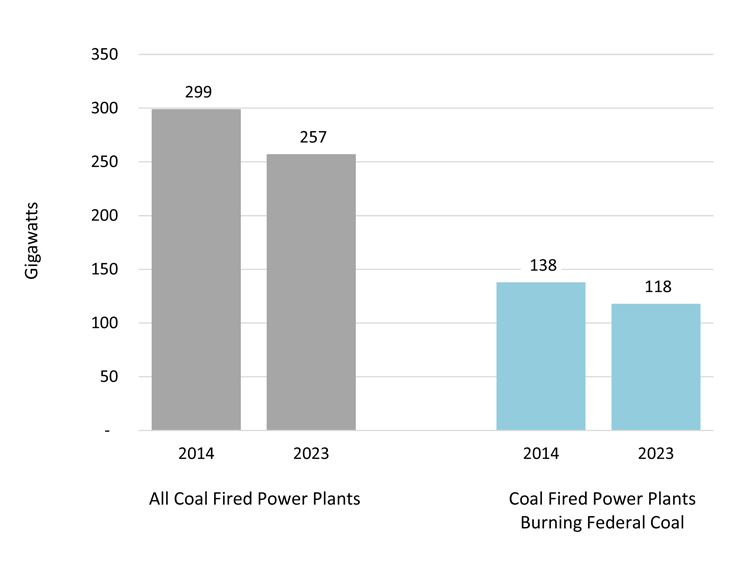Lower overall coal generating capacity—the outcome of coal fired power plant retirements and a demand for coal that rises and falls depending on natural gas prices—will create new volatility for coal jobs and for counties, schools, and states that depend on tax revenues from coal.
Changing coal markets influenced the Department of Interior’s (DOI) decision to impose a three-year pause on new federal coal leases while it reviews the existing federal coal-leasing program. During the pause, the DOI will assess the social and economic contributions of federal coal production, including an assessment of how changing energy markets may affect coal production, jobs, and revenue.
This blog explores how coal-fired power plant retirements and competition from natural gas are impacting the utilization of both federal and non-federal coal.
Total Generating Capacity of All Coal-Fired Power Plants and Those Burning Federal Coal Will Decline by 2023

Retirements of Coal-Fired Power Plants Restrict Coal Generating Capacity
Retirements occur when plants are no longer economically viable due to factors including competition with natural gas and the cost of complying with new air quality regulations. Nation-wide, coal generating capacity has declined 15 percent from 318 to 278 gigawatts between 2011 and 2015 as some coal-fired power plants have retired.
More coal-fired power plants are scheduled to retire. Total coal generation capacity, as predicted by the Energy Information Administration (EIA), will decline to 257 gigawatts by 2023 (based on retirements planned through 2022 reported to the Energy Information Administration), reducing total generating capacity by 22 percent from 2011.
From 2014 (latest year available) to 2023, capacity at coal fired power plants that utilize federal coal will also drop, declining from 138 to 118 gigawatts, a 14 percent reduction in total generating capacity.
The decline in total generating capacity as coal-fired power plants are retired restricts the maximum amount of coal that can be burned if coal-fired power plants are run at their peak capacity.
Competition from Cheap Natural Gas Reduces the Share of Coal-Fired Generating Capacity Used
For the first time, natural gas is consistently priced lower than coal. Direct competition from cheap natural gas has reduced not only the number of coal-fired power plants in the U.S, but also how much of the nation’s remaining coal-fired generation capacity is used to generate electricity.
The Energy Information Administration reports that utilization of coal-fired power plants (the share of total generation capacity employed to generate power) has fallen from an average of 67 percent to 55 percent from 2005 to 2015.
In turn, lower utilization of total generation capacity means less coal is burned relative to the maximum amount that could be burned if power plants were run at peak capacity. For example, SNL Energy estimated that mines delivered 135 million fewer tons to power plants in 2015 due to natural gas prices cutting into coal utilization.
The impact of cheap natural gas has been similar for power plants that burn federal coal. The share of total generation capacity of power plants that burn coal sourced from mines with federal leases fell from 67 percent in 2009 to 61 percent in 2015 (data on power plants sourcing coal from federal mines is not available before 2009).
The intensity with which coal-fired power plants are operated in the future will depend on direct competition with natural gas. This means that utilization of the nation’s remaining coal-fired generation capacity may rise during periods of higher natural gas prices and fall again when natural gas prices drop.
Coal supply markets will experience greater volatility as a result of lower long-term demand for coal due to coal plant retirements and less certain short-term demand for coal due to competition with natural gas. Managing this new volatility will require innovative and often difficult fiscal and economic choices at the local, state, and federal level.
Methods
Headwaters Economics has compiled data and analysis on the socioeconomic context of the federal coal program.
Data sources and methods for the topics covered in this blog are described below.
Generation capacity is the maximum electric output an electricity generator can produce under specific conditions. Net summer capacity is typically determined by a performance test and indicates the maximum electricity load a generator can support at the point of interconnection with the electricity transmission and distribution system during the summer season.
Generating capacity in this blog is defined as net summer generation capacity measured in Gigawatts of power generating potential. Data are from the EIA 860 surveys. Net generating capacity of individual coal-fired power generators are added together to estimate total generation capacity of the nation’s coal-fired power plant fleet.
EIA data also details the mine(s) that each coal fired power plant receives coal deliveries from. These mines are joined to a list of Bureau of Land Management coal leases to determine which coal fired power plants burn coal sourced from mines that have federal leases.
Net generation is the amount of gross electricity generation a generator produces minus the electricity used to operate the power plant. These electricity uses include fuel handling equipment, water pumps, combustion and cooling air fans, pollution control equipment, and other electricity needs.
Capacity factors describe how intensively a fleet of generators is run. The capacity factor is net generation as a share of generating capacity.
Data Sources
Energy Information Administration, Detailed EIA-860 Survey, 2014 Washington, D.C.
Energy Information Administration, Form EIA-923 Detailed Data, 2014, Washington, D.C.
U.S. Bureau of Land Management, “Cross Reference of BLM Coal Lease Serial Numbers and MSHA Identification Numbers,” February 3, 2015. 1278-FOIA (860), FOIA# 2015-00462.



